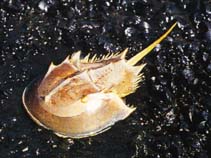Advertisement
Limulus polyphemus (Linnaeus, 1758)
Horseshoe crab| Native range | All suitable habitat | Point map | Year 2050 |

|
| This map was computer-generated and has not yet been reviewed. |
| Limulus polyphemus AquaMaps Data sources: GBIF OBIS |
country information
Common names:
[No common name]
Occurrence:
Salinity:
Abundance: | Ref:
Importance: | Ref:
Aquaculture: | Ref:
Regulations: | Ref:
Uses: no uses
Comments:
National Checklist:
Country Information:
National Fisheries Authority:
Occurrences: Occurrences Point map
National Database:
Occurrence:
Salinity:
Abundance: | Ref:
Importance: | Ref:
Aquaculture: | Ref:
Regulations: | Ref:
Uses: no uses
Comments:
National Checklist:
Country Information:
National Fisheries Authority:
Occurrences: Occurrences Point map
National Database:
Common names from other countries
رده بندی / Names اسامي عام | مترادف | Catalog of Fishes (gen., sp.) | ITIS | CoL | WoRMS
Environment: milieu / climate zone / depth range / distribution range بوم شناسي
Distribution كشورها | مناطق سازمان خوار و بار جهاني (FAO) | Ecosystems | ظهور | معرفي
Western Atlantic: from Maine, USA to Mexico.
Length at first maturity / Size / Weight / سن
Maturity: Lm ? range ? - ? cm Max length : 60.0 cm TL جنس نر / بدون خواص جنسي; (مرجع 82); بيشينه وزن گزارش شده: 1.8 kg (مرجع 82); بيشينه سن گزارش شده: 20 سال ها (مرجع 99652)
The males are approximately 1/3 the size of the females (sexual dimorphism) (Ref. 83). Lives in shallow waters, with sandy or muddy bottoms (Ref. 76). Found in intertidal and offshore areas (Ref. 1131). The horseshoe crab feeds at night on polychaete worms such as Cerebratulus, Nereis, and Cistenides (Ref. 76, 77), small mollusks, and seaweed (algae) found in the sandy ocean bottom (Ref. 76). Food is picked up by the chelicerae and passed back to the bristle bases, where it is "chewed." The food is then moved forward to the mouth (Ref. 75). It digs its food from sediments, grasping the prey with its legs. The prey is moved to the gnathobases where it is crushed before being pushed forward toward the mouth (Ref. 77). A life span of about 20 to 40 years (Ref. 78). Its predators are loggerhead turtles, pufferfish, leopard sharks and sea gulls (Ref. 82).
Life cycle and mating behavior بلوغ | تولید مثل | تخم ریزی | Eggs | Fecundity | Larvae
They reproduce with the use of the first pair of the six, flap-like appendages on the underside of the abdomen acts as a cover for the genital pore. The egg or sperm are released through this pore during spawning (Ref. 75). These eggs are fertilized by sperm released by an attached male and by one or more satellite males that typically congregate around the nesting pair (Ref. 81). While nesting, females bury themselves in the sediment near the water's edge and lay a series of discrete egg clusters, each containing 2,000-20,000 eggs (Ref. 80).
مآخذ اصلی
مراجع | هماهنگ كننده | همكاران
Lee, C.N. and B. Morton. 2005. (مرجع 1131)
وضعيت در فهرست قرمز IUCN
(مرجع 130435: Version 2024-2)
آسیب پذیر، به فهرست قرمز IUCN مراجعه کنید (VU) (A3bd); Date assessed: 17 February 2016
وضعيت از نظر سايتس (مرجع 108899)
Not Evaluated
CMS (مرجع 116361)
Not Evaluated
خطر برای انسان ها
Harmless
استفاده انسانی
ماهي گيري – شيلات: تجاري
FAO - ماهي گيري – شيلات: landings | FIRMS (Stock assessments) | FishSource | Sea Around Us
ابزارها
اطلاعات بيشتر
منابع اينترنتي
BHL | BOLD Systems | CISTI | DiscoverLife | FAO(ماهي گيري – شيلات: ; publication : search) | GenBank (ژنوم, نوکلئوتيد) | GloBI | Gomexsi | Google Books | Google Scholar | Google | PubMed | Tree of Life | Wikipedia (برو, جستجو) | Zoological Record
Estimates based on models
Preferred temperature
(Ref. 115969): 12.5 - 28, mean 26.7 (based on 417 cells).




